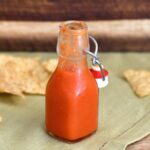Low Sodium Fermented Hot Sauce
Want to make a low-sodium hot sauce that still is fermented? This recipe uses raw ACV or brewed kombucha for a fermented salt-free hot sauce!
- Prep Time: 5 minutes
- Total Time: 5 minutes
- Yield: 1 1/2 cups 1x
- Category: Condiment
- Method: Fermented
- Diet: Low Salt
Ingredients
Units
Scale
- 12 oz (about 1 1/2 cups) peppers and other flavors (see section above for options)
- 2 cloves of garlic
- 1/4 cup of raw apple cider vinegar (or kombucha)
- 1 Tbsp of sugar (to feed the ferment)
- 1/2 tsp of salt (optional, added after fermenting)
Instructions
- I don’t recommend using 100% chili peppers unless you want to make an extremely HOT sauce. I usually use a mix of chili peppers and sweet peppers. Alternatively, you can replace some of the peppers with other flavors. I enjoy making hot sauce with some fruit. See the section above for some recommended flavor combinations.
- Wash and take the stems off the peppers. Place them in the blender with the garlic. The heat will depend on the variety of pepper used and whether you keep the seeds. I recommend including the seeds for maximum spiciness.
- Add the apple cider vinegar and sugar to the blender. Pulse until everything turns into a smooth paste. Scrape the pepper smoothie into a jar glass for fermenting. It doesn’t need to be a special fermentation jar. Just use a lid that will allow CO2 to escape as it ferments. As you can see from the photos, I use a regular mason jar, however, I don’t tighten the lid.
- Place the jar somewhere dark. A kitchen cupboard is perfect. Let the hot sauce ferment for at least 3 days and up to 14 days. It will slowly become less sweet and more acidic the longer it ferments. Hot peppers and apple cider vinegar are both prone to contamination with kahm yeast. If you are concerned about kahm yeast, then I recommend only fermenting for 3 to 5 days. However, kahm yeast is perfectly safe and will naturally die off as the sugars are fermented.
- Stir the hot sauce every 2 to 3 days. Oxygen is a necessary part of this ferment.
- When it’s finished fermenting, the hot sauce can be strained or put through a food mill to remove any large seeds. However, this is just for aesthetics and it’s fine to use the hot sauce without straining.
- Feel free to add salt after fermenting. I’ve recommended 1/2 tsp, but it’s fine to use more or less depending on taste. Store the finished hot sauce in an air-tight container in the fridge. It will last for up to 1 year. Alternatively, freeze the hot sauce for long-term storage.
Notes
- I have a really good blender, so my hot sauce is super smooth. However, before I got my current blender, I used an inexpensive blender that left the seeds whole. It’s fine to make a “rustic” looking hot sauce with whole seeds.
- I usually bottle part of my hot sauce and freeze the rest in straight-sided jam jars. My fridge doesn’t have enough space to store all my ferments!
